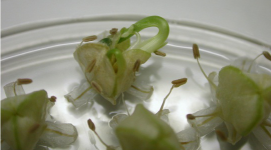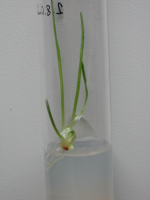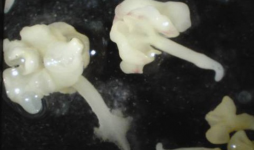(Edit: this thread sprung from this thread)
Hi Spurr!
Here is a new thread to discuss doubled haploid breeding. My appointments all canceled this morning and I have some free time to spend!
You said:
My knowledge of this is minimal, I haven't studied DH directly, only tangentially in relation to something else I was looking into. This is my understanding of the process:
Homozygous diploid plants are created using haploid cells from one plant, instead of two parents. This is done two ways:
1: By outcrossing to something distantly related to the plant you are working with, something similar enough to get viable seed, but distant enough so that the haploid contribution from the other plant is not expressed, resulting in a haploid plant. These haploids are then treated to double the haploid to homozygous diploid. I don't think this is of any use in pot.
2: By culturing gametes. Pollen and ova are, obviously, haploid. If you can coax either one of them into growing into a plant by themselves, you end up with a haploid plant that is sterile. Using chemicals, you can induce them to double this single haploid contribution into a homozygous diploid capable of reproduction. Usually it is the pollen that is used, as culturing individual ova is much more difficult.
Illustration of above.
Most of the plants that are bred using DH are monecious, like cereal grains. Being self fertile simplifies the process.
The use of DH in diecious plants seems to be limited to crops that being all male is a plus. Asparagus is a good example. Hemp too, maybe?
DH in Asparagus from good book on DH breeding.
The way I understand it (I could be totally wrong), is that the reason for this is (in a diecious plant) that when you double a haploid that is female you get XX. When you double a male haploid you get either XX or YY. When your haploid plant comes from a pollen grain that would have produced a female plant in normal reproduction, it will be XX when doubled. If the pollen grain was one that would have produced a male plant in normal reproduction it would be YY when doubled, and although fertile, would be incapable of contributing a X to offspring, making all seeds from the cross male. Of course you could reverse the females and breed those.
Part of good book on DH breeding that tells of how it is particularly useful in self-pollinating (monecious) plants.
Another part of the same book that discusses DH in diecious plants. Click the "Page 28" link to see the whole page.
Good paper on DH in rapeseed (mustard like plant that canola oil comes from). Papers like this discouraged me from thinking about trying this at home.
Hi Spurr!
Here is a new thread to discuss doubled haploid breeding. My appointments all canceled this morning and I have some free time to spend!
You said:
As I understand things, one can make DiHap strains from a female and a male (using TC and mutagens), then cross once they are grown out as mature DiHap plants. The resulting seed will not be DiHap, it will be 2N, but will be fixed for (some) goal traits. Feminization, and selfing, is/are route(s) some academics have taken, IIRC.
My knowledge of this is minimal, I haven't studied DH directly, only tangentially in relation to something else I was looking into. This is my understanding of the process:
Homozygous diploid plants are created using haploid cells from one plant, instead of two parents. This is done two ways:
1: By outcrossing to something distantly related to the plant you are working with, something similar enough to get viable seed, but distant enough so that the haploid contribution from the other plant is not expressed, resulting in a haploid plant. These haploids are then treated to double the haploid to homozygous diploid. I don't think this is of any use in pot.
2: By culturing gametes. Pollen and ova are, obviously, haploid. If you can coax either one of them into growing into a plant by themselves, you end up with a haploid plant that is sterile. Using chemicals, you can induce them to double this single haploid contribution into a homozygous diploid capable of reproduction. Usually it is the pollen that is used, as culturing individual ova is much more difficult.
Illustration of above.
Most of the plants that are bred using DH are monecious, like cereal grains. Being self fertile simplifies the process.
The use of DH in diecious plants seems to be limited to crops that being all male is a plus. Asparagus is a good example. Hemp too, maybe?
DH in Asparagus from good book on DH breeding.
The way I understand it (I could be totally wrong), is that the reason for this is (in a diecious plant) that when you double a haploid that is female you get XX. When you double a male haploid you get either XX or YY. When your haploid plant comes from a pollen grain that would have produced a female plant in normal reproduction, it will be XX when doubled. If the pollen grain was one that would have produced a male plant in normal reproduction it would be YY when doubled, and although fertile, would be incapable of contributing a X to offspring, making all seeds from the cross male. Of course you could reverse the females and breed those.
Part of good book on DH breeding that tells of how it is particularly useful in self-pollinating (monecious) plants.
Another part of the same book that discusses DH in diecious plants. Click the "Page 28" link to see the whole page.
Good paper on DH in rapeseed (mustard like plant that canola oil comes from). Papers like this discouraged me from thinking about trying this at home.







